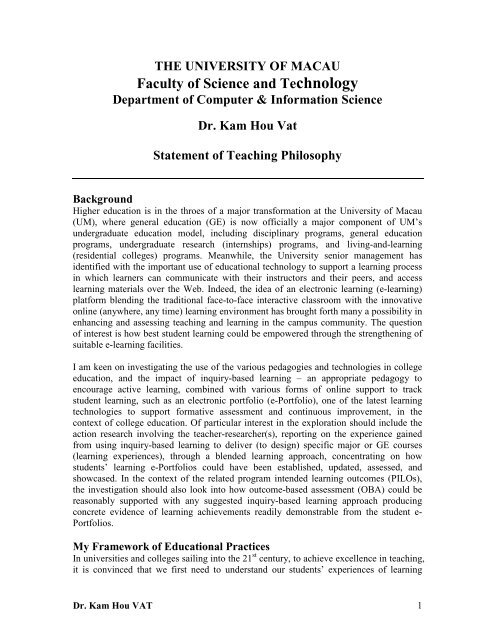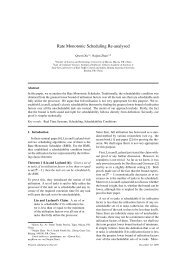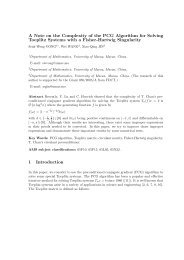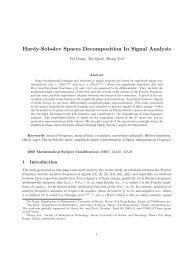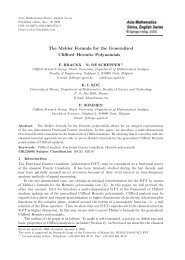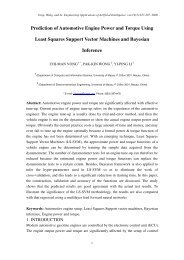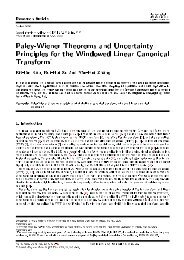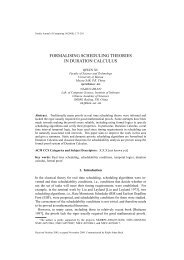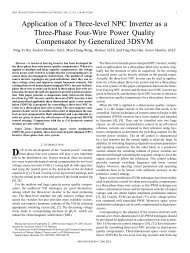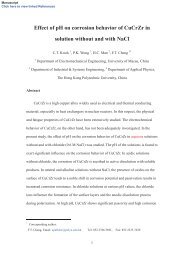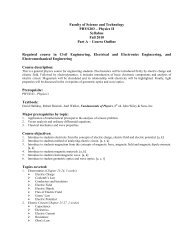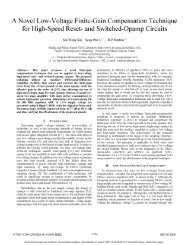Teaching Philosophy - Faculty of Science and Technology ...
Teaching Philosophy - Faculty of Science and Technology ...
Teaching Philosophy - Faculty of Science and Technology ...
You also want an ePaper? Increase the reach of your titles
YUMPU automatically turns print PDFs into web optimized ePapers that Google loves.
THE UNIVERSITY OF MACAU<strong>Faculty</strong> <strong>of</strong> <strong>Science</strong> <strong>and</strong> <strong>Technology</strong>Department <strong>of</strong> Computer & Information <strong>Science</strong>Dr. Kam Hou VatStatement <strong>of</strong> <strong>Teaching</strong> <strong>Philosophy</strong>BackgroundHigher education is in the throes <strong>of</strong> a major transformation at the University <strong>of</strong> Macau(UM), where general education (GE) is now <strong>of</strong>ficially a major component <strong>of</strong> UM’sundergraduate education model, including disciplinary programs, general educationprograms, undergraduate research (internships) programs, <strong>and</strong> living-<strong>and</strong>-learning(residential colleges) programs. Meanwhile, the University senior management hasidentified with the important use <strong>of</strong> educational technology to support a learning processin which learners can communicate with their instructors <strong>and</strong> their peers, <strong>and</strong> accesslearning materials over the Web. Indeed, the idea <strong>of</strong> an electronic learning (e-learning)platform blending the traditional face-to-face interactive classroom with the innovativeonline (anywhere, any time) learning environment has brought forth many a possibility inenhancing <strong>and</strong> assessing teaching <strong>and</strong> learning in the campus community. The question<strong>of</strong> interest is how best student learning could be empowered through the strengthening <strong>of</strong>suitable e-learning facilities.I am keen on investigating the use <strong>of</strong> the various pedagogies <strong>and</strong> technologies in collegeeducation, <strong>and</strong> the impact <strong>of</strong> inquiry-based learning – an appropriate pedagogy toencourage active learning, combined with various forms <strong>of</strong> online support to trackstudent learning, such as an electronic portfolio (e-Portfolio), one <strong>of</strong> the latest learningtechnologies to support formative assessment <strong>and</strong> continuous improvement, in thecontext <strong>of</strong> college education. Of particular interest in the exploration should include theaction research involving the teacher-researcher(s), reporting on the experience gainedfrom using inquiry-based learning to deliver (to design) specific major or GE courses(learning experiences), through a blended learning approach, concentrating on howstudents’ learning e-Portfolios could have been established, updated, assessed, <strong>and</strong>showcased. In the context <strong>of</strong> the related program intended learning outcomes (PILOs),the investigation should also look into how outcome-based assessment (OBA) could bereasonably supported with any suggested inquiry-based learning approach producingconcrete evidence <strong>of</strong> learning achievements readily demonstrable from the student e-Portfolios.My Framework <strong>of</strong> Educational PracticesIn universities <strong>and</strong> colleges sailing into the 21 st century, to achieve excellence in teaching,it is convinced that we first need to underst<strong>and</strong> our students’ experiences <strong>of</strong> learningDr. Kam Hou VAT 1
(Hartley, Hilsdon, Keenan, Sinfield & Varity, 2011). To improve our teaching inparticular, we need to apply evidence from research into student learning (Light, Cox, &Calkins, 2009). My experience as a teacher in the past 18 or so years shows there aresolutions that may work better or worse for each individual teacher, each department, <strong>and</strong>each group <strong>of</strong> students. The motivation behind my conceiving this statement is to reflectthrough reason combined with intuition, on the context <strong>of</strong> designing suitable technologyenhancedlearning experiences as user-participants <strong>of</strong> a virtual learning environment(VLE), including such components as a course management system, say, MOODLE,some compatible e-Portfolio tools to support learning development, a customizablepedagogy such as inquiry-based learning, <strong>and</strong> an adaptable course delivery strategy, say,blended learning model, under perhaps, some environmental expectations, say, outcomesbasedassessment.Inquiry-Based LearningAccording to Hepworth <strong>and</strong> Walton (2009), in the educational context, inquiry-basedlearning (or enquiry-based learning) has been recognized as a powerful tool for learningabout a subject domain, <strong>and</strong> more importantly for learning how to learn, as it helpspeople to develop their independent learning skills. Hutchings (2007, p.13) asserted thefollowing:In inquiry-based learning, the learning is self-directed because it is driven bystudents’ own decisions about appropriate ways in which an issue or scenario mightbe approached. They bring to bear on the topic any existing knowledge or experiencerelevant to the issues.No person comes to the table with no knowledge, <strong>and</strong> the examination <strong>and</strong> pooling <strong>of</strong>what is already known allow students to gain confidence, as well as to practice thehabit <strong>of</strong> reflection. They carry out research <strong>and</strong> investigations into areas that theydecide are essential for a proper response to the issue.Thus, they discover how to research by engaging in practical examples. In this way, itmay be said that the process <strong>of</strong> enquiry is in the ownership <strong>of</strong> the students, so thatenquiry-based learning is fundamentally concerned with establishing the context, thespace, the environment within which enquiry may best be stimulated <strong>and</strong> students cantake charge <strong>of</strong> their learning.The process is student-centered, with the onus always on the students to takeinitiatives, propose routes <strong>of</strong> enquiry <strong>and</strong> follow them thoughtfully. By these means,students also acquire experience in a range <strong>of</strong> intellectual <strong>and</strong> social capabilities.These include critical thinking, reflection <strong>and</strong> self-criticism, teamwork, independence,autonomous thinking <strong>and</strong> information literacy.Literature items related to inquiry-based learning include the following:• Centre for Excellence in Enquiry-Based Learning, The University <strong>of</strong> Manchester.Available at: http://www.campus.manchester.ac.uk/ceebl/resources/papers/Dr. Kam Hou VAT 2
• Healey, M. (2009). Active learning <strong>and</strong> learning styles: A selected bibliography.Centre for Active Learning (CeAL), UK. Availableat: http://resources.glos.ac.uk/shareddata/dms/7A5EC57BBCD42A039B4046B28A1917D6.pdf• Hepworth, M. & Walton, G. (2009). <strong>Teaching</strong> information literacy for inquirybasedlearning. Oxford, Engl<strong>and</strong>: Ch<strong>and</strong>os Publishing.• Hutchings, W. (2007). Enquiry-based learning: definitions <strong>and</strong> rationale.Manchester: Centre for Excellence in Enquiry-Based Learning.Outcomes-Based AssessmentAccording to Driscoll <strong>and</strong> Wood (2007), the idea behind the context <strong>of</strong> outcomes-basedassessment is the fundamental question, “What did the student learn?” It is closely relatedto the growing concerns about the quality <strong>of</strong> higher education. It is about building sharedresponsibility for student learning (Conzemius & O’Neill, 2001) through somecollaborative analysis <strong>of</strong> student works (Boud & Falchikov, 2007). It requires that facultycome together to determine what curricular <strong>and</strong> course outcomes should be. It isimportant that teachers <strong>and</strong> students are part <strong>of</strong> an educational system in which each partaffects the behaviors <strong>and</strong> properties <strong>of</strong> the whole. When teachers <strong>and</strong> students cometogether to contemplate their collective input – something that had previously most beentaken for granted, carried out privately by individual instructors, <strong>and</strong> seen little reason toimprove, increasingly more faculty members have realized that much college teachingcould have been improved by decades <strong>of</strong> research on human learning (Suskie, 2009;Maki, 2010). In particular, we are aware today that students learn more if we set highexpectations for them; engage them actively in their learning; provide opportunities forthem to interact in connection with their work with faculty <strong>and</strong> with other students; <strong>and</strong>assess their progress <strong>of</strong>ten, providing timely feedback.Literature items related to outcomes-based assessment include the following:• Boud, D., & Falchikov, N. (2007). Rethinking assessment in higher education.London, UK: Routledge.• Bresciani, M.J. (2006). Implementing outcomes-based assessment <strong>of</strong> studentlearning. PPT (PowerPoint Presentation) availableat: http://interwork.sdsu.edu/elip/consultation/presentations/implement_assmt_stu_learning.pdf• Carter. M. (2003). A process for establishing outcomes-based assessment plansfor writing <strong>and</strong> speaking in the disciplines. Language <strong>and</strong> Learning Across theDisciplines, 6(1). Available at: http://wac.colostate.edu/llad/v6n1/carter.pdf• Conzemius, A., & O’Neill, J. (2001). Building shared responsibility for studentlearning. Alex<strong>and</strong>ria, VA: Association for Supervision <strong>and</strong> CurriculumDevelopment.• Driscoll, A., & Wood, S. (2007). Developing outcomes-based assessment forlearner-centered education: A faculty introduction. Sterling, VA: Stylus.• Gannod, G.G. (2009). Outcomes-based assessment process. PPT (PowerPointPresentation)availableat: http://www.units.muohio.edu/celt/assessment/student_success/CSA_Powerpoint.pdfDr. Kam Hou VAT 3
Bourne & J.C. Moore (Eds.), Elements <strong>of</strong> quality online education: Practice <strong>and</strong>direction (pp. 29-38). Volume 4 in the Sloan C Series, Needham, MA: The SloanConsortium.• Garrison, D. (2004). Transformative leadership <strong>and</strong> e-learning. In K. Matheos &T. Carey (Eds.), Advances <strong>and</strong> challenges in eLearning at Canadian researchuniversities (pp.46-54). CHERD Occasional Papers in Higher Education, 12,University <strong>of</strong> Manitoba.• Garrison, D. (2006). Online community <strong>of</strong> inquiry review: Underst<strong>and</strong>ing social,cognitive <strong>and</strong> teaching presence. Invited paper presented to the Sloan ConsortiumAsynchronous Learning Network Invitational Workshop, Baltimore, MD, August.• Garrison, D., & Anderson, T. (2011). E-Learning in the 21 st century: A frameworkfor research <strong>and</strong> practice, 2e. London, UK: Routledge/Falmer.• Garrison, D., & Archer, W. (2007). A community <strong>of</strong> inquiry framework for onlinelearning. In M. Moore (ed.), H<strong>and</strong>book <strong>of</strong> distance education. New York, NY:Erlbaum.• Garrison, D., & Vaughan, N. (2008). Blended learning in highereducation: Frameworks, principles, <strong>and</strong> guidelines. San Francisco, CA:Jossey-Bass.• Kuh, G.D., Kinzie, J., Schuh, J.H., Whitt, E.J., & Associates. (2005). Studentsuccess in college: Creating conditions that matter. San Francisco: Jossey-Bass.• Littlejohn, A., & Pegler, Chris (2007). Preparing for blended e-Learning. NewYork: Routledge• Sharpe, R., Benfield, G., Roberts, G. & Francis, R. (2006). The undergraduateexperience <strong>of</strong> blended e-learning: A review <strong>of</strong> UK literature <strong>and</strong> practice. HigherEducation Academy. Availableat: http://hca.ltsn.ac.uk/assets/documents/research/literature_reviews/blended_elearning_exec_summary_1.pdfLearning e-PortfoliosThe use <strong>of</strong> portfolios for teaching <strong>and</strong> documenting student work has been around for along time in a number <strong>of</strong> fields (Stefani, Mason, & Pegler, 2007), including portfolios inboth composition <strong>and</strong> creative writing, in the visual arts, <strong>and</strong> in architecture <strong>and</strong> interiordesign. In the context <strong>of</strong> college education, learning portfolios are those assembled bystudents for individual courses. They document <strong>and</strong> reflect upon the ways in which thestudents have met the outcomes for particular courses. Instructor’s endorsement is <strong>of</strong>tenrequired to authenticate the course learning portfolios from students. Program learningportfolios are developed by students to document the work they have completed, theskills they have learned, <strong>and</strong> the outcomes they have accomplished in an academicdepartment or program. The mentor or appraiser could add comments as feedback. Itcould be a requirement for graduation. Besides, students might use a selection from theirprogram learning portfolios to show to prospective employers, as important steps <strong>of</strong>career planning (Lorenzo & Ittelson, 2005).Despite being effective as mechanisms for showcasing student work, the traditionalpaper-based portfolios were not easily shared among audiences geographicallyDr. Kam Hou VAT 5
distributed, <strong>and</strong> were not easily modified for different purposes <strong>and</strong> for diverse audiences.With the advent <strong>of</strong> the Internet starting in the 1990s, we have witnessed the opportunityto experiment with the concept <strong>of</strong> electronic learning portfolios (e-Portfolios) (PennyLight, Chen, & Ittelson, 2012; Jafari & Kaufman, 2006; Cambridge, 2001). Still,whatever the primary focus <strong>of</strong> engagement with students, the use <strong>of</strong> e-Portfoliosinevitably adds a strong online element to the teaching <strong>and</strong> learning activities.In particular, institutions <strong>of</strong> higher education need to provide electronic support <strong>and</strong>services; teachers need access <strong>and</strong> skills to integrate the e-Portfolio application into theiroverall course design, <strong>and</strong> students need a wide range <strong>of</strong> electronic abilities in order todevelop their e-Portfolios. The underlying pedagogy <strong>of</strong> e-Portfolio use is considered animportant link with e-Learning, too. It is believed as mentioned earlier, that the use <strong>of</strong>inquiry-based learning should prove promising in the final analysis.Literature items related to the e-Portfolio model include the following:• Cambridge, B.L. (2001). Electronic portfolios: Emerging practices in student,faculty, <strong>and</strong> institutional learning. Sterling, VA: Stylus.• Cambridge, D. (2010). Eportfolios for lifelong learning <strong>and</strong> assessment. SanFrancisco: Jossey-Bass.• Cambridge, D., Cambridge B., & Yancey, K. (2009). Electronic portfolios 2.0:Emergent research on implementation <strong>and</strong> impact. Sterling, VA: Stylus.• Chen, H.L., & Penny Light, T. (2010). Electronic portfolios <strong>and</strong> student success:Effectiveness, efficiency, <strong>and</strong> learning. Washington, DC: Association <strong>of</strong> AmericanColleges <strong>and</strong> Universities.• Jafari, A. & Kaufman, C. (2006). H<strong>and</strong>book <strong>of</strong> research on ePortfolios. Hershey:Idea Group Reference.• Lorenzo, G., & Ittelson, J. (2005). An overview <strong>of</strong> institutional e-portfolios. In D.Oblinger (Ed.), Educause learning initiative. Available onlineat: http://www.educause.edu/ir/library/pdf/ELI3002.pdf (last accessed May 10,2008)• Penny Light, T., Chen, H., & Ittelson, J. (2012). Documenting learning withePortfolios: A guide for college instructors. San Francisco: Jossey-Bass.• Stefani, L., Mason R., & Pegler, C. (2007). The educational potential <strong>of</strong> e-portfolios: Supporting personal development <strong>and</strong> reflective learning. New York:Routledge• Zubizarreta, J. (2009). The learning portfolio: Reflective practice for improvingstudent learning, 2e. San Francisco: Jossey-Bass.My Observations <strong>and</strong> InterpretationsCollege instructors are rarely taught to teach. Meeting Ph.D. requirements has beencounted as sufficient qualification to teach others, <strong>and</strong> it is true that many instructorsdevelop excellent skills on the job without formal training or consultation. Yet, thequestion remains: Why strive for excellence in the classroom? My answer is simple, butintrinsic: It is a moral calling for me to be an effective teacher, <strong>and</strong> such a calling requiresconstant efforts to assiduously go beyond minimal expectations. Undoubtedly, theDr. Kam Hou VAT 6
doctorate carries with it both a sense <strong>of</strong> intellectual mastery <strong>and</strong> <strong>of</strong> moral responsibility,whose integration helps prepare for the many roles <strong>of</strong> the scholar - discovery <strong>and</strong>synthesis, teaching <strong>and</strong> service.The workplace <strong>of</strong> the 21st century requires pr<strong>of</strong>essionals who not only have an extensivestock <strong>of</strong> knowledge, but who also know how to keep the knowledge up-to-date, whoapply it to solve problems, <strong>and</strong> who function as part <strong>of</strong> a team. Those <strong>of</strong> us who teachundergraduates in higher educational institutions are obligated to rethink how we teach<strong>and</strong> what our students need to learn in order to prepare them for this challenging time.Yet, with few exceptions, we faculty <strong>of</strong>ten teach as we were taught. And for most <strong>of</strong> us,that experience revolved around lectures, which are usually content-driven, emphasizingabstract concepts over concrete examples <strong>and</strong> applications. Assessment techniques focuson recall <strong>of</strong> information <strong>and</strong> facts, <strong>and</strong> rarely challenge students to perform at highercognitive levels <strong>of</strong> underst<strong>and</strong>ing. This didactic instruction reinforces in students a naiveview <strong>of</strong> learning in which the teacher is responsible for delivering content <strong>and</strong> thestudents are the passive receivers <strong>of</strong> knowledge. Indeed, lecturing, though still anefficient means <strong>of</strong> educational delivery, does little to foster the development <strong>of</strong> processskills to complement content knowledge. In this light, I personally identify with JohnDewey's observation that true learning should be based on discovery (inquiry) guided bymentoring rather than the transmission <strong>of</strong> knowledge.My Goals for Student LearningIn June <strong>of</strong> 1994 (while I was just two-year old in my service at UM), a WingspreadConference was held in Denver, Colorado, USA, to discuss the quality in undergraduateeducation in the States (Wingspread, 1994). The discussion that took place was based onthe assertion that substantial improvement in American undergraduate education isneeded to prepare students to function successfully in the global <strong>and</strong> their homeenvironments. The Conference developed the following list <strong>of</strong> important characteristics<strong>of</strong> quality performance expected <strong>of</strong> college graduates:1. Higher-level skills in communication, computation, technological literacy, <strong>and</strong>information retrieval to enable individuals to gain <strong>and</strong> apply new knowledge <strong>and</strong>skills as needed;2. The ability to arrive at informed judgments - that is, to effectively define problems,gather <strong>and</strong> evaluate information related to those problems, <strong>and</strong> develop solutions;3. The ability to function in a global community through the possession <strong>of</strong> a range <strong>of</strong>attitudes <strong>and</strong> dispositions including flexibility <strong>and</strong> adaptability, ease with diversity,motivation <strong>and</strong> persistence (say, being a self-starter), ethical <strong>and</strong> civil behavior,creativity <strong>and</strong> resourcefulness, <strong>and</strong> the ability to work with others, especially in teamsettings;4. Technical competence in a given field;5. Demonstrated ability to deploy all <strong>of</strong> the previous characteristics to address specificproblems in complex, real-world settings, in which the development <strong>of</strong> workablesolutions is required.My Experience <strong>of</strong> College EducationDr. Kam Hou VAT 7
No doubt, what worked in the classroom a decade or two ago (while I was still beingeducated in college in the US), will no longer suffice to develop the full battery <strong>of</strong> skills<strong>and</strong> abilities desired in such a contemporary university graduate (refer to the attributesabove). To enable college students to learn with their own initiatives, it has beenobserved (Huba & Freed, 2000) that there is a growing tendency away from a traditionaltransmission-based pedagogy in higher education, towards a pedagogy that can broadlybe characterized as constructivist. By transmission pedagogy, I mean teaching based onan assumption that student receive information from the teacher <strong>and</strong> slot it straight into anempty place in their knowledge base, or at best, work on it later to make it their own. Byconstructivist pedagogy, I mean an approach to learning through a variety <strong>of</strong> knowledgebuilding processes, <strong>and</strong> that teaching should encourage students to work actively towardsunderst<strong>and</strong>ing within a framework <strong>of</strong> personal responsibility <strong>and</strong> institutional freedom.Within the culture <strong>of</strong> transmission teaching, what constitutes good learning has largelybeen based on success in examinations designed to test the quantity <strong>and</strong> the quality <strong>of</strong>what individual students have learned, in the sense <strong>of</strong> giving back, in an appropriate form,that which the teachers taught <strong>and</strong> the textbooks told. The constructivist shift brings newdimensions to the notion <strong>of</strong> good learning, such as being able to find information <strong>and</strong>knowledge by oneself; <strong>of</strong> being able to look critically at what one finds; <strong>of</strong> being able toquestion one's teachers; <strong>of</strong> being able to collaborate with colleagues (fellow students);<strong>and</strong> <strong>of</strong> being able to discuss what one knows with one's peers <strong>and</strong> with the public. In thisregard, as the need to examine a student's work as a whole is m<strong>and</strong>ated, such as how bestto measure responsibly what the student learns in college, our traditional mode <strong>of</strong>educational delivery becomes increasingly problematic (currently being so much revealedby the Collegiate Learning Assessment movement in the US), <strong>and</strong> the notion <strong>of</strong> goodteaching shifts away from the role <strong>of</strong> presenter <strong>and</strong> towards the much more complex role<strong>of</strong> guide <strong>and</strong> coach, as so much exemplified in the current trend <strong>of</strong> outcomes-basedteaching <strong>and</strong> learning (OBTL) as well as outcomes-based assessment (OBA) (Driscoll &Wood, 2007).My Confession as a Reflective College TeacherIt is my confession that the conventional approach to education at UM remains theinstructivist (transmission-based) mode today, in which knowledge is perceived to flowfrom experts to novices. This transmission view <strong>of</strong> learning assumes that the process <strong>of</strong>good teaching is one <strong>of</strong> simplification <strong>of</strong> the truth in order to reduce student confusion.Yet, such simplification could deny students the opportunity to apply their learning todynamic situations. We <strong>of</strong>ten question the transferability <strong>of</strong> the instructivist learning <strong>and</strong>ask how much <strong>of</strong> that which is assigned to academic learning ever gets applied to actualscenarios, when there is such a rapid surge in knowledge commonly associated with theadvent <strong>of</strong> the Internet era. This is a transference problem. Empirically, the contentproduct <strong>of</strong> learning is assuming a less important role relative to the process <strong>of</strong> learning asthe life <strong>of</strong> information content shortens <strong>and</strong> the need for continual learning increases. It isincreasingly accepted today that learning could be viewed as a constructive processoccurring during one's participation in <strong>and</strong> contribution to the practices <strong>of</strong> the community<strong>of</strong> learners. This is supported by UM's 4-in-1 model <strong>of</strong> education, in which learning incommunities through our residential college system is a clear demonstration <strong>of</strong> the belief.Indeed, teaching <strong>and</strong> learning in higher education is shifting from the cognitive focus onDr. Kam Hou VAT 8
knowledge structures presumed in the mind <strong>of</strong> the individual learner, to a constructivistfocus on the learner as an active participant in a social context. Our classroom culture isalso being transformed from the obsession with knowledge reproduction, to theenrichment with electronic learning platforms (such as UMMoodle, or later Sakai OpenAcademic Environment) that are meant to facilitate the mediation <strong>of</strong> knowledge building<strong>and</strong> social exchanges among peers as participants in the discourse communities. Suchcommunities <strong>of</strong> learning (physical or virtual) open opportunities for learners to interactwith multiple perspectives, which challenge their existing knowledge constructions <strong>and</strong>impose cognitive conflicts, requiring negotiations <strong>and</strong> <strong>of</strong>ten teacher's or mentor'scontinual interventions. Unquestionably, it takes a certain amount <strong>of</strong> independence <strong>and</strong>determination to change the way one teaches. It also takes time (presumably reserved forour research - scholarship <strong>of</strong> discovery) <strong>and</strong> involves risks (such as undesirable studentratings among a community <strong>of</strong> students so accustomed to the transmission mode <strong>of</strong>teaching <strong>and</strong> learning). So, where do instructors acquire the commitment (courage toteach; dare to try <strong>and</strong> to risk) to get started with this change?My Leap <strong>of</strong> Faith in Effective <strong>Teaching</strong>In the fall <strong>of</strong> 1998 (while I was just six-year old in my service at UM), I started exploringthe pedagogy <strong>of</strong> problem-based learning (PBL) in my teaching the junior core course (inthe old 4-year undergraduate S<strong>of</strong>tware Engineering curriculum) SFTW300 S<strong>of</strong>twarePsychology, designed to introduce to students the human behavior in s<strong>of</strong>twaredevelopment. It was <strong>and</strong> has been quite an impressive learning experience for mystudents <strong>and</strong> myself, though we had/have had a number <strong>of</strong> obstacles to overcome,including the counseling <strong>of</strong> students in groups (rigorous group work). I still remember theemphatic comment <strong>of</strong> one student yelling, "It is never good to work in a group with noconfidants <strong>of</strong> my own!" The major hurdle is to encourage students to keep on theirresearch-analysis-implementation schedule (amidst their tight schedule <strong>of</strong> classes - six toseven courses per semester, taken for granted at UM-FST, instead <strong>of</strong> being exceptionalfor high-performing students, as in the US), including such tasks as reading articlesbefore or in time for class discussion (or more precisely, conducting group-baseddiscourse, small-group discussion), <strong>and</strong> learning how to critique on other groups' ideas inorder to help improve the group's work for the next round <strong>of</strong> discourse. The academicefforts exerted over the years, have led to a number <strong>of</strong> important publications publicizingto the world that we at the University <strong>of</strong> Macau (UM), are also partakers <strong>of</strong> qualityundergraduate computer science education, though ours was misnamed S<strong>of</strong>twareEngineering from 1989 until this year when our <strong>of</strong>ficial Computer <strong>Science</strong> program hasbeen launched in the fall <strong>of</strong> 2011. As an aside, the essence <strong>of</strong> PBL can be summarized bythe fact that it addresses, besides the necessary course content knowledge, directly many<strong>of</strong> the recommended <strong>and</strong> desirable outcomes <strong>of</strong> an undergraduate education, with specialattention to the ability to do the following for both students <strong>and</strong> teacher concerned:1. Think critically <strong>and</strong> be able to analyze <strong>and</strong> solve complex, real-world problems;2. Find, evaluate, <strong>and</strong> use appropriate learning resources;3. Work cooperatively in teams <strong>and</strong>/or small groups;4. Demonstrate versatile <strong>and</strong> effective communication skills, both verbal <strong>and</strong> written;Dr. Kam Hou VAT 9
5. Use content knowledge <strong>and</strong> intellectual skills acquired at the university to becomecontinual learners.Selected PublicationsVat, K.H. (2000), "Training E-Commerce Support Personnel for Enterprises throughAction Learning," presented <strong>and</strong> published in Proceedings <strong>of</strong> the 2000 ACM SIGCPRConference, Apr. 6-8, Chicago, Illinois, USA, pp.39-43.Vat, K.H. (2000), "<strong>Teaching</strong> S<strong>of</strong>tware Psychology: Exp<strong>and</strong>ing the Perspective,"presented <strong>and</strong> published in Proceedings <strong>of</strong> the Thirty-first SIGCSE TechnicalSymposium on Computer <strong>Science</strong> Education, Mar. 8-12, Austin, Texas, USA,pp.392-396.Vat, K.H. (2001), "<strong>Teaching</strong> HCI with Scenario-Based Design: The Constructivist'sSynthesis," presented <strong>and</strong> published in Proceedings <strong>of</strong> the Sixth Annual ACMConference on Innovation <strong>and</strong> <strong>Technology</strong> in Computer <strong>Science</strong> Education(ITiCSE2001), Canterbury, U.K., Jun. 25-27, pp. 9-12.Vat, K.H. (2001), "Addressing IT/IS Personnel Shortfall: Some PBL Students' Findings<strong>and</strong> Recommendations," presented <strong>and</strong> published in Proceedings <strong>of</strong> the FourthAnnual Conference <strong>of</strong> the Southern Association for Information Systems (SAIS2001),Mar. 2-3, Savannah, Georgia, USA, pp. 52-60.Vat, K.H. (2004), "Toward a Learning Organization Model for Student Empowerment: ATeacher-Designer's Experience as a Coach by the Side," presented <strong>and</strong> published inthe Proceedings <strong>of</strong> the 2004 IADIS International Conference on Cognition <strong>and</strong>Exploratory Learning in Digital Age (CELDA2004), Dec. 15-17, Lisbon, Portugal,pp.131-140.Vat, K.H. (2006), "Integrating S<strong>of</strong>t Systems Methodology into the <strong>Teaching</strong> <strong>of</strong> Human-Computer Interaction: A Constructivist Design Based on Problem-Based Learning,"presented <strong>and</strong> published in the CD-Proceedings <strong>of</strong> the Society for Information<strong>Technology</strong> <strong>and</strong> Teacher Education International Conference (SITE2006), Mar. 20-24,Orl<strong>and</strong>o, Florida, USA.Vat, K.H. (2006), "Nurturing Self-Directed Work Teams in the Education <strong>of</strong> InformationSystems Pr<strong>of</strong>essionals," presented <strong>and</strong> published in the CD-Proceedings <strong>of</strong> the NinethAnnual Conference <strong>of</strong> the Southern Association for Information Systems (SAIS2006),Mar. 11-12, Jacksonville, Florida, USA (http://sais.aisnet.org/2006/Vat-SAIS2006-paper.pdf).Vat, K.H. (2006), "<strong>Teaching</strong> a Collaborative Model <strong>of</strong> IS Development through Problem-Based Learning," in Information Systems Education Journal (ISSN: 1545-679x),Volume 4, Number 102, October (http://isedj.org/4/102/).Vat, K.H. (2006), "Integrating Industrial Practices in S<strong>of</strong>tware Development throughScenario-Based Design <strong>of</strong> PBL Activities: A Pedagogical Re-OrganizationPerspective," in Journal <strong>of</strong> Issues in Informing <strong>Science</strong> <strong>and</strong> Information <strong>Technology</strong>(ISSN: 1547-5859 CD Version), Volume 3, June, pp. 687-708 (Choose Volume 3from http://iisit.org/ or click direct fromhttp://informingscience.org/proceedings/InSITE2006/IISITVat229.pdf).Vat, K.H. (2009), "Virtual Organizing Pr<strong>of</strong>essional Learning Communities through aServant-Leader Model <strong>of</strong> Appreciative Coaching," in Y. Inoue (Ed.), Cases on Online<strong>and</strong> Blended Learning Technologies in Higher Education: Concepts <strong>and</strong> PracticesDr. Kam Hou VAT 10
(ISBN 978-1-60566-880-2). Hershey, PA, USA: Information <strong>Science</strong> Reference (IGIGlobal, Inc.) (http://www.igi-global.com/reference/details.asp?ID=34829), pp.183-206.My Personal Growth PlanIt is my belief that including a section on personal growth as a university teacher is alsoimportant in a statement <strong>of</strong> teaching philosophy. The reflective component can illustratehow I have grown in teaching over the years, what challenges exist at the present, <strong>and</strong>what long-term goals are projected. Firstly, I am convinced that it is essential for teachersto provide a framework to guide students' learning process, <strong>and</strong> this framework mustcomprise, at least, the following three main ideas <strong>of</strong> empowerment I found to beextremely important to live up to:a) Enable students to determine what they need to learn through questioning <strong>and</strong> goalsetting. It is my belief that students should work to identify their knowledge <strong>and</strong> skilldeficits, <strong>and</strong> to develop strategies in the form <strong>of</strong> personal learning goals for meetingthose deficits. Also, they should learn to relate what they know to what they do notknow <strong>and</strong> ask questions to guide their quest for new knowledge. The emphasis is t<strong>of</strong>oster a sense <strong>of</strong> student ownership in the learning process. If teachers, say, throughthe PBL approach, can guide the students in the identification <strong>of</strong> what they alreadyknow <strong>and</strong> what they need to learn, then knowledge gaps <strong>and</strong> mistakes can be viewedin a positive way such as another opportunity to learn. And students can assume moreresponsibility in addressing their own learning needs during any instructional unit.b) Enable students to manage their own learning activities. It is my belief that studentsshould be enabled to develop their learning plans, which should describe priorities,instructional tactics, resources, deadlines, roles in collaborative learning situations,<strong>and</strong> proposed learning outcomes, including presentation <strong>and</strong> dissemination <strong>of</strong> newknowledge <strong>and</strong> skills, if applicable. Traditionally, these instructional events arearranged by teachers to be obeyed by students throughout a semester or school year,in order to accomplish a specified set <strong>of</strong> pre-determined objectives. Yet, in that case,it is not advantageous for students to learn to take the initiative. To manage their ownlearning activities, students must be guided <strong>and</strong> supported by the teacher, slowlytaking on more <strong>and</strong> more responsibility <strong>of</strong> their own learning.c) Enable students to contribute to each other's learning through collaborative activities.It is my belief that students should be motivated <strong>and</strong> supported in discussing <strong>and</strong>sharing information. Particularly, we should enable students to become co-builders <strong>of</strong>the course resources through evaluating <strong>and</strong> refining the work their peers contributeto the class. Collaborative learning seems appealing to achieve that purpose; however,it involves not just creating a group <strong>and</strong> then dividing up the work. Students must beeducated to recognize what they are trying to learn in group-work, value it, <strong>and</strong> wishto share that value with others. Teachers can provide this sense <strong>of</strong> accountability bystructuring the group work to include both individual <strong>and</strong> group assessments, as in thePBL (problem-based learning) style <strong>of</strong> collaboration.Dr. Kam Hou VAT 11
Secondly, it is my lifelong learning that effective teaching must be understood <strong>and</strong>practiced in the following context <strong>of</strong> higher educational challenges (courtesy <strong>of</strong> Queen'sUniversity, Ontario, Canada):1. Effective teaching is a scholarly activity which is integral to the duties <strong>of</strong> all facultymembers, <strong>and</strong> to which they are expected to devote substantial proportions <strong>of</strong> theirpr<strong>of</strong>essional time. Effective teachers place high value on the teaching enterprise <strong>and</strong>the subject taught, manifest knowledge, interest <strong>and</strong> enthusiasm, <strong>and</strong> provideappropriate intellectual challenges to students. By inspiring <strong>and</strong> encouraging students,effective teachers draw students into the world <strong>of</strong> the disciplines, the university, <strong>and</strong>the habit for inquiry that guides the lifelong search for underst<strong>and</strong>ing.2. Effective teachers have excellent communication skills, which include: a) clarity inthe organization <strong>and</strong> presentation <strong>of</strong> ideas; b) consistency <strong>and</strong> clarity on expectedst<strong>and</strong>ards <strong>of</strong> student work; c) timely, appropriate, <strong>and</strong> helpful assessment <strong>of</strong> studentperformance; d) constructive feedback to students; <strong>and</strong> e) opportunities for interactionwith individual students <strong>and</strong> among students.3. Effective teaching employs appropriate curriculum design delivery, <strong>and</strong> attends to thedevelopment, evaluation, <strong>and</strong> revision <strong>of</strong> curricula. Effective teachers employappropriate course design <strong>and</strong> instructional methods, <strong>and</strong> are consistent in theirattention to the development, evaluation <strong>and</strong> revision <strong>of</strong> courses. Materials <strong>and</strong>teaching strategies should: a) be academically challenging; b) encourage criticalthought <strong>and</strong> intellectual exchange; c) take account <strong>of</strong> recent developments inscholarship; d) reflect the diversity <strong>of</strong> student experience <strong>and</strong> issues, <strong>and</strong> the breadth<strong>and</strong> depth <strong>of</strong> their knowledge; e) be well organized <strong>and</strong> coherent; f) be stimulating,responsive, flexible <strong>and</strong> open to modification in keeping with students' needs; <strong>and</strong> g)take account <strong>of</strong> recent development in the delivery <strong>of</strong> curriculum, such as innovativeinstructional technologies <strong>and</strong> alternative teaching strategies.4. Effective teachers recognize <strong>and</strong> engage with the diversity <strong>of</strong> student experience <strong>and</strong>intellectual perspectives. <strong>Teaching</strong> is a highly complex interplay <strong>of</strong> relationshipsbetween teachers <strong>and</strong> students within which an effective teacher reveals <strong>and</strong>encourages respect for differences among students <strong>and</strong> seeks to draw on that diversityin a way that builds a constructive experience <strong>of</strong> learning for all. Effective teachersare therefore committed to the equitable treatment <strong>of</strong> all students <strong>and</strong> tounderst<strong>and</strong>ing <strong>and</strong> removing barriers to learning that may have impeded the academicprogress <strong>of</strong> those who are non-traditional students.5. Effective teachers promote both independent <strong>and</strong> collaborative learning on the part <strong>of</strong>students by fostering the talents, skills, abilities, <strong>and</strong> most important, the desire <strong>of</strong>students to take responsibility for continued learning.6. Effective teachers are reflective, self-critical <strong>and</strong> flexible. They consistently seek tolearn from their students, from their own teaching, <strong>and</strong> from the teaching <strong>of</strong> others,<strong>and</strong>, in response, are willing to modify their instructional approaches. The committedDr. Kam Hou VAT 12
teacher also serves as a role model <strong>and</strong> mentor to colleagues. What is effectiveteaching may vary with particular disciplines as teachers seek to address a widevariety <strong>of</strong> students, <strong>and</strong> approach diverse topics in diverse ways at various levels <strong>of</strong>expertise. Effective teaching <strong>and</strong> learning occurs through intensive interaction <strong>of</strong>teachers <strong>and</strong> students in a variety <strong>of</strong> places, both inside <strong>and</strong> outside the classroom,<strong>and</strong> as changing technologies <strong>of</strong>fer new opportunities for exp<strong>and</strong>ing <strong>and</strong> diversifyingthe contexts <strong>of</strong> learning.Thirdly, it is my commitment to teach effectively so as to facilitate student learning, <strong>and</strong> Iam convinced that a teacher’s commitment to develop <strong>and</strong> to maintain a <strong>Teaching</strong>Dossier (or better named <strong>Teaching</strong> Portfolio) to keep track <strong>of</strong> one’s teaching performancemust be demonstrated, with the following possible items for ongoing perusal:A) The Products <strong>of</strong> Good <strong>Teaching</strong>• Students' scores on teacher-made or st<strong>and</strong>ardized tests, possibly before <strong>and</strong> after acourse has been taken as evidence <strong>of</strong> learning;• Student laboratory workbooks <strong>and</strong> other kinds <strong>of</strong> workbooks or logs;• Student essays, creative work, <strong>and</strong> project or field-work reports;• Publications by students on course-related work;• A record <strong>of</strong> students who select <strong>and</strong> succeed in advanced courses <strong>of</strong> study in thefield;• A record <strong>of</strong> students who elect another course with the same pr<strong>of</strong>essor;• Evidence <strong>of</strong> effective supervision <strong>of</strong> Honors, Master's, or Ph.D. theses;• Setting up or running a successful internship program;• Documentary evidence <strong>of</strong> the effect <strong>of</strong> courses on student career choice;• Documentary evidence <strong>of</strong> help given by the pr<strong>of</strong>essor to students in securingemployment;• Evidence <strong>of</strong> help given to colleagues on teaching improvement.B) Materials from TeacherDescriptive materials on current <strong>and</strong> recent teaching responsibilities <strong>and</strong> practices• List <strong>of</strong> course titles <strong>and</strong> numbers, unit values or credits, enrolments with briefelaboration;• List <strong>of</strong> course materials prepared for students;• Information <strong>of</strong> pr<strong>of</strong>essor's availability to students;• Report on identification <strong>of</strong> student difficulties <strong>and</strong> encouragement <strong>of</strong> studentparticipation in courses or programs;• Description <strong>of</strong> how films, computers or other non-print materials were used inteaching;• Steps taken to emphasize the interrelatedness <strong>and</strong> relevance <strong>of</strong> different kinds <strong>of</strong>learning.Dr. Kam Hou VAT 13
Descriptions <strong>of</strong> steps taken to evaluate <strong>and</strong> improve one's teaching• Maintaining a record <strong>of</strong> the changes resulting from self-evaluation;• Reading journals on improving teaching <strong>and</strong> attempting to implement acquiredideas;• Reviewing new teaching materials for possible application;• Exchanging course materials with a colleague from another institution;• Conducting research on one's own teaching or course;• Becoming involved in an association or society concerned with the improvement<strong>of</strong> teaching <strong>and</strong> learning;• Attempting instructional innovations <strong>and</strong> evaluating their effectiveness;• Using general support services such as the Education Resources InformationCentre (ERIC) in improving one's teaching;• Participating in seminars, workshops <strong>and</strong> pr<strong>of</strong>essional meetings intended toimprove teaching;• Participating in course or curriculum development;• Pursuing a line <strong>of</strong> research that contributes directly to teaching;• Preparing textbook or other instructional materials;• Editing or contributing to a pr<strong>of</strong>essional journal on teaching one's subject.C) Information from OthersStudents• Student course <strong>and</strong> teaching evaluation data which suggest improvements orproduce an overall rating <strong>of</strong> effectiveness or satisfaction;• Written comments from a student committee to evaluate courses <strong>and</strong> providefeedback;• Unstructured (<strong>and</strong> possibly unsolicited) written evaluations by students, includingwritten comments on exams <strong>and</strong> letters received after a course has beencompleted;• Documented reports <strong>of</strong> satisfaction with out-<strong>of</strong>-class contacts;• Interview data collected from students after completion <strong>of</strong> a course;• Honors received from students, such as being elected "teacher <strong>of</strong> the year".Colleagues• Statements from colleagues who have observed teaching either as members <strong>of</strong> ateaching team or as independent observers <strong>of</strong> a particular course, or who teachother sections <strong>of</strong> the same course;• Written comments from those who teach courses for which a particular course is aprerequisite;• Evaluation <strong>of</strong> contributions to course development <strong>and</strong> improvement;• Statements from colleagues from other institutions on such matters as how wellstudents have been prepared for graduate studies;Dr. Kam Hou VAT 14
• Honors or recognition such as distinguished teacher award or election to acommittee on teaching;• Requests for advice or acknowledgement <strong>of</strong> advice received by a committee onteaching or similar body.Other Sources• Statements about teaching achievements from administrators at one's owninstitution;• Alumni ratings for other graduate feedback;• Comments from parents <strong>of</strong> students;• Reports from employers <strong>of</strong> students (e.g., in a work-study or cooperativeprogram);• Invitations to teach for outside agencies;• Invitations to contribute to the teaching literature;• Other kinds <strong>of</strong> invitations based on one's reputation as a teacher (for example, amedia interview on a successful teaching innovation).My Perceived Significance <strong>of</strong> a Sustainable <strong>Teaching</strong> CommitmentAmong the perceived contributions <strong>of</strong> a sustainable teaching commitment include:• Specific organizational learning to be accrued <strong>and</strong> shared among institutions <strong>of</strong> highereducation, especially in Macau, in the context <strong>of</strong> documenting student learningparticularly through the use <strong>of</strong> e-Portfolios;• Pinpointed case studies <strong>of</strong> how student learning can be produced <strong>and</strong> enhancedthrough different pedagogical <strong>and</strong> technological designs that are enacted in a blendedlearning environment, characterized by the use <strong>of</strong> course or learning managementsystems;• Extended underst<strong>and</strong>ing <strong>and</strong> interpretation <strong>of</strong> the nature <strong>of</strong> individual <strong>and</strong> collectiveparticipation in inquiry-based learning directed at growth <strong>and</strong> development inacademic (teaching <strong>and</strong> learning) endeavors in pursuit <strong>of</strong> excellence (personal orcollaborative knowledge creation);• Close examination <strong>of</strong> the contextual dynamics (social, cultural, <strong>and</strong> political analysis)within which technology-enhanced learning in the specific institution <strong>of</strong> highereducation takes place, <strong>and</strong> how best to respond to <strong>and</strong> improve the situation <strong>of</strong>concerns (e.g., culture <strong>and</strong> learning, educational reform, policy re-orientation).Finally, but not the least, it is my goal to be able to see to the development <strong>and</strong> realization<strong>of</strong> the following system <strong>of</strong> relevance <strong>and</strong> excellence:A university-own system,operated by skilled pr<strong>of</strong>essionals,which, under the learning-centered initiative <strong>of</strong> college education,develops <strong>and</strong> maintains a virtual space <strong>of</strong> learning,called UM REALSpace, for students, teachers, <strong>and</strong> administrators,Dr. Kam Hou VAT 15
developed through collaborative <strong>and</strong> participatory approach,in order to contribute to meaningful student learningin relation to curriculum/learning development, <strong>and</strong>the learning-teaching-assessing (LTA) processes<strong>of</strong> college educationREALSpace – Rich Environment for Active Learning SpaceReferencesBenfield, G. & Roberts, G. (2008). Blended e-Learning in HE. Oxford Centre for Staff<strong>and</strong> Learning Development. (PDF PPT). Availableat: https://mw.brookes.ac.uk/download/attachments/6160945/Blended_eLearning+%28h<strong>and</strong>outs%29.pdf?version=1Boud, D., & Falchikov, N. (2007). Rethinking assessment in higher education. London,UK: Routledge.Bresciani, M.J. (2006). Implementing outcomes-based assessment <strong>of</strong> student learning.PPT (PowerPoint Presentation) availableat: http://interwork.sdsu.edu/elip/consultation/presentations/implement_assmt_stu_learning.pdfCambridge, B.L. (2001). Electronic portfolios: Emerging practices in student, faculty,<strong>and</strong> institutional learning. Sterling, VA: Stylus.Cambridge, D. (2010). Eportfolios for lifelong learning <strong>and</strong> assessment. San Francisco:Jossey-Bass.Cambridge, D., Cambridge B., & Yancey, K. (2009). Electronic portfolios 2.0: Emergentresearch on implementation <strong>and</strong> impact. Sterling, VA: Stylus.Carter. M. (2003). A process for establishing outcomes-based assessment plans forwriting <strong>and</strong> speaking in the disciplines. Language <strong>and</strong> Learning Across theDisciplines, 6(1). Available at: http://wac.colostate.edu/llad/v6n1/carter.pdfChen, H.L., & Penny Light, T. (2010). Electronic portfolios <strong>and</strong> student success:Effectiveness, efficiency, <strong>and</strong> learning. Washington, DC: Association <strong>of</strong> AmericanColleges <strong>and</strong> Universities.Conzemius, A., & O’Neill, J. (2001). Building shared responsibility for student learning.Alex<strong>and</strong>ria, VA: Association for Supervision <strong>and</strong> Curriculum Development.Driscoll, A., & Wood, S. (2007). Developing outcomes-based assessment for learnercenterededucation: A faculty introduction. Sterling, VA: Stylus.Gannod, G.G. (2009). Outcomes-based assessment process. PPT (PowerPointPresentation)availableat: http://www.units.muohio.edu/celt/assessment/student_success/CSA_Powerpoint.pdf.Garrison, D. (2003). Cognitive presence for effective asynchronous online learning: Therole <strong>of</strong> reflective inquiry, self-direction <strong>and</strong> meta-cognition. In J. Bourne & J.C.Moore (Eds.), Elements <strong>of</strong> quality online education: Practice <strong>and</strong> direction (pp. 29-38). Volume 4 in the Sloan C Series, Needham, MA: The Sloan Consortium.Garrison, D. (2004). Transformative leadership <strong>and</strong> e-learning. In K. Matheos & T. Carey(Eds.), Advances <strong>and</strong> challenges in eLearning at Canadian research universities(pp.46-54). CHERD Occasional Papers in Higher Education, 12, University <strong>of</strong>Manitoba.Dr. Kam Hou VAT 16
Garrison, D. (2006). Online community <strong>of</strong> inquiry review: Underst<strong>and</strong>ing social,cognitive <strong>and</strong> teaching presence. Invited paper presented to the Sloan ConsortiumAsynchronous Learning Network Invitational Workshop, Baltimore, MD, August.Garrison, D., & Anderson, T. (2011). E-Learning in the 21 st century: A framework forresearch <strong>and</strong> practice, 2e. London, UK: Routledge/Falmer.Garrison, D., & Archer, W. (2007). A community <strong>of</strong> inquiry framework for onlinelearning. In M. Moore (ed.), H<strong>and</strong>book <strong>of</strong> distance education. New York, NY:Erlbaum.Garrison, D., & Vaughan, N. (2008). Blended learning in higher education:Frameworks, principles, <strong>and</strong> guidelines. San Francisco, CA: Jossey-Bass.Hartley, P., Hilsdon, J., Keenan, C., Sinfield, S, & Verity, M. (2011). Universities intothe 21 st century: Learning development in higher education. London, Engl<strong>and</strong>:Palgrave (Macmillan).Healey, M. (2009). Active learning <strong>and</strong> learning styles: A selected bibliography. Centrefor Active Learning (CeAL), UK. Availableat: http://resources.glos.ac.uk/shareddata/dms/7A5EC57BBCD42A039B4046B28A1917D6.pdfHepworth, M. & Walton, G. (2009). <strong>Teaching</strong> information literacy for inquiry-basedlearning. Oxford, Engl<strong>and</strong>: Ch<strong>and</strong>os Publishing.Huba, M.E., & Freed, J.E. (2000). Learner-centered assessment on college campuses:Shifting the focus from teaching to learning. Boston: Allyn <strong>and</strong> Bacon.Hutchings, W. (2007). Enquiry-based learning: definitions <strong>and</strong> rationale. Manchester:Centre for Excellence in Enquiry-Based Learning.Jafari, A. & Kaufman, C. (2006). H<strong>and</strong>book <strong>of</strong> research on ePortfolios. Hershey: IdeaGroup Reference.Kuh, G.D., Kinzie, J., Schuh, J.H., Whitt, E.J., & Associates. (2005). Student success incollege: Creating conditions that matter. San Francisco: Jossey-Bass.Light, G., Cox, R., & Calkins, S. (2009). Learning <strong>and</strong> teaching in higher education: Thereflective pr<strong>of</strong>essional, 2e. London, Engl<strong>and</strong>: Sage.Littlejohn, A., & Pegler, Chris (2007). Preparing for blended e-Learning. New York:Routledge.Lorenzen, M. (2004). Using outcome-based education in the planning <strong>and</strong> teaching <strong>of</strong>new information technologies. Available at: http://www.libraryinstruction.com/obe.html.Lorenzo, G., & Ittelson, J. (2005). An overview <strong>of</strong> institutional e-portfolios. In D.Oblinger (Ed.), Educause learning initiative. Available onlineat: http://www.educause.edu/ir/library/pdf/ELI3002.pdf (last accessed May 10, 2008)Maki, P. (2010). Assessing for learning: Building a sustainable commitment across theinstitution, 2e. Sterling, VA: Stylus.Penny Light, T., Chen, H., & Ittelson, J. (2012). Documenting learning with ePortfolios:A guide for college instructors. San Francisco: Jossey-Bass.Sharpe, R., Benfield, G., Roberts, G. & Francis, R. (2006). The undergraduate experience<strong>of</strong> blended e-learning: A review <strong>of</strong> UK literature <strong>and</strong> practice. Higher EducationAcademy.Availableat: http://hca.ltsn.ac.uk/assets/documents/research/literature_reviews/blended_elearning_exec_summary_1.pdfStefani, L., Mason R., & Pegler, C. (2007). The educational potential <strong>of</strong> e-portfolios:Supporting personal development <strong>and</strong> reflective learning. New York: Routledge.Dr. Kam Hou VAT 17
Suskie, L. (2009). Assessing student learning: A common sense guide, 2e. San Francisco:Jossey-Bass.Wingspread Conference. (1994). Quality Assurance in Undergraduate Education: Whatthe Public Expects. Denver, CO: Education Commission <strong>of</strong> the StatesZubizarreta, J. (2009). The learning portfolio: Reflective practice for improving studentlearning, 2e. San Francisco: Jossey-Bass.Dr. Kam Hou VAT 18


